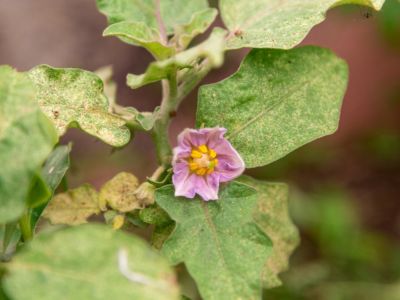Yellow Eggplant Fruit
Most people think of large, waxy, purple fruits when eggplant comes to mind. Although many eggplants are purple, not every variety produces this iconic fruit color. Eggplant fruits can range in color from pale green to a deep purple that looks black, including many that appear in shades of yellow, or even white. If you’ve never grown a specific variety before, yellow could simply be the color of the fruit on your plant. Light colored eggplants are prone to yellowing when they’re approaching an over-ripe state. If this color is appearing on your larger eggplants, but sparing the smaller ones, try harvesting the fruits earlier. Another common cause of yellowing of eggplants is sunburn, which happens when leaves are damaged or removed, exposing the skin of tender, young fruits to excessive ultraviolet radiation. This damage may appear as cream to tan spots, or might cover the entire exposed surface of the fruit.
Eggplant with Yellow Leaves
Eggplant turning yellow may be indicative of more serious problems if the yellowing is on leaves. Spider mites and lace bugs can cause yellowing when they feed on plant leaves. As the insect populations increase, these damaged leaves may drop or dry up, leading to sunburn on fruits. Both of these pests can be controlled with a premixed insecticidal soap, applied once a week until all signs of the pests are gone. Yellowing of leaves is often caused by care problems like irregular watering or a lack of nitrogen in the soil. Plants that aren’t getting enough water may initially wilt during midday, yellowing as the water stress increases. Apply 2 to 4 inches (5-8 cm.) of organic mulch and water these plants more frequently, preferably in the morning. Eggplants that develop overall yellowing may need nitrogen — a soil test will quickly reveal if this is the situation. A dose of balanced fertilizer, like a 10-10-10, will quickly remedy this situation. If the soil pH is too high or low, your plant won’t be able to utilize the nitrogen in the soil, no matter how much you apply, so make sure to test soil pH along with nutrient levels. Early blight and Verticillium wilt are caused by fungal pathogens that are common in the soil. Both diseases come on suddenly, sometimes only affecting part of the plant at first. Eventually, the yellowing will spread across the entire plant as it dies from an inability to transport nutrients to its tissues. These fungal diseases are difficult or impossible to treat, but copper fungicides and chlorothalonil are labeled for pretreatment for early blight. Crop rotation is effective chemical-free prevention. Eggplant viruses may cause yellow circles, spots, or other irregular patterns on eggplant leaves. Many plant viruses are transmitted by pest insects as they feed, or from plant-to-plant contact via dirty tools. Plant viruses are incurable so be sure to remove infected plants immediately and destroy them to prevent further spread.
